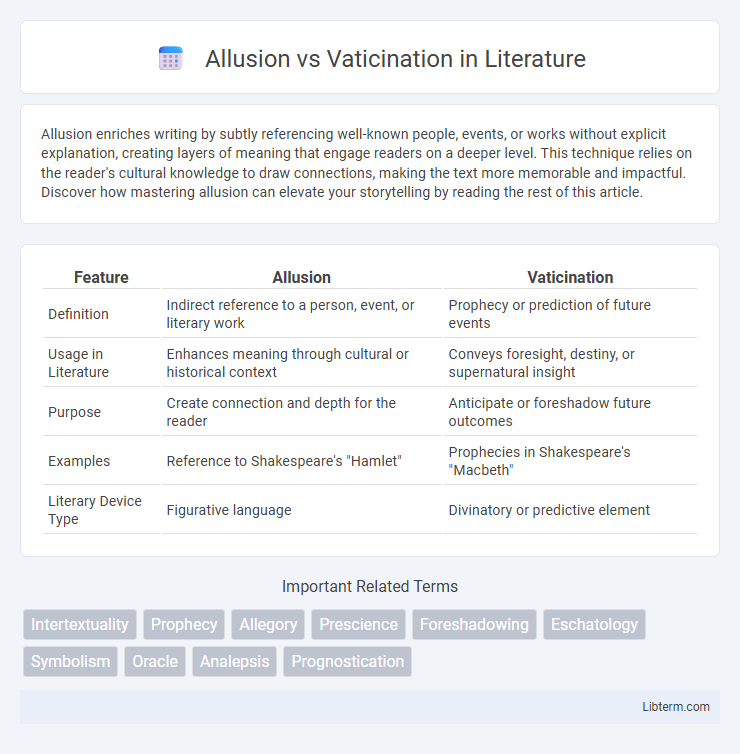Allusion enriches writing by subtly referencing well-known people, events, or works without explicit explanation, creating layers of meaning that engage readers on a deeper level. This technique relies on the reader's cultural knowledge to draw connections, making the text more memorable and impactful. Discover how mastering allusion can elevate your storytelling by reading the rest of this article.
Table of Comparison
| Feature | Allusion | Vaticination |
|---|---|---|
| Definition | Indirect reference to a person, event, or literary work | Prophecy or prediction of future events |
| Usage in Literature | Enhances meaning through cultural or historical context | Conveys foresight, destiny, or supernatural insight |
| Purpose | Create connection and depth for the reader | Anticipate or foreshadow future outcomes |
| Examples | Reference to Shakespeare's "Hamlet" | Prophecies in Shakespeare's "Macbeth" |
| Literary Device Type | Figurative language | Divinatory or predictive element |
Understanding Allusion: Definition and Examples
Allusion is a literary device where a writer references a person, place, event, or work of art indirectly to enrich the meaning without explicit description. Common examples include referencing classical mythology, historical events, or famous literature to evoke associated ideas and emotions, such as mentioning "Achilles' heel" to signify vulnerability. Understanding allusion enhances text interpretation by recognizing these implicit connections that add depth and context.
Decoding Vaticination: Meaning and Usage
Vaticination refers to the act of prophesying or predicting future events, often perceived as a divine or mystical insight. Decoding vaticination involves understanding its context in literature or speech, where it conveys a forecast or an ominous warning rather than just a casual reference. This distinguishes Vaticination from an allusion, which merely hints at or indirectly references another work or idea without the predictive or prophetic element.
Historical Origins of Allusion and Vaticination
Allusion originated in classical literature, with roots tracing back to Latin rhetoric where authors embedded indirect references to myths, historical events, or earlier texts to enrich meaning and engage learned audiences. Vaticination stems from ancient prophetic traditions in Mesopotamia and Greece, where seers and oracles conveyed divine revelations, often through cryptic or symbolic language intended to predict future events. Both allusion and vaticination utilize indirect communication but differ fundamentally in purpose: allusion aims to evoke shared cultural knowledge, while vaticination seeks to reveal hidden futures through interpretive prophecy.
Key Differences Between Allusion and Vaticination
Allusion refers to an indirect reference to a person, event, or literary work within a text, enriching the meaning through implied connections. Vaticination involves predicting or prophesying future events, often based on intuition or supernatural insight. Key differences lie in allusion's role as a rhetorical device for evoking past knowledge, while vaticination serves as a forecast emphasizing foresight and divination.
Allusion in Literature and Popular Culture
Allusion in literature and popular culture refers to a brief and indirect reference to a person, event, or work, enriching the text by invoking familiar ideas or symbolism without explicit explanation. This technique enhances narrative depth and resonates with audiences by tapping into collective cultural or historical knowledge, making connections that deepen thematic complexity. Famous examples include Shakespeare's plays referencing classical mythology and modern films echoing iconic literary works to create layered meanings.
Vaticination in Prophecy and Prediction
Vaticination refers to the act of foretelling future events with a degree of authority or divine insight, often found in prophecy where predictions are believed to be inspired by supernatural sources. Unlike allusion, which indirectly references a concept or event, vaticination involves direct and explicit declarations about what is to come, commonly seen in religious texts and oracle pronouncements. The semantic distinction emphasizes vaticination as a form of predictive speech grounded in mystical or revelatory context rather than a mere symbolic or figurative reference.
Functions of Allusion vs Vaticination in Communication
Allusion functions in communication by indirectly referencing known ideas, events, or texts to enrich meaning and evoke shared cultural knowledge, enhancing engagement and interpretation. Vaticination serves as a tool for predictive communication, conveying foresight or prophecy to influence beliefs and decisions about future possibilities. While allusion anchors messages in existing contexts for deeper understanding, vaticination projects uncertainty or anticipation to guide audience perspectives on what is yet to come.
Semantic Impact: How Allusion and Vaticination Shape Meaning
Allusion enriches meaning by referencing cultural or literary contexts that evoke shared knowledge and emotions, creating layered interpretations within a text. Vaticination, as prophetic or visionary speech, shapes meaning by introducing elements of prediction and foresight that influence readers' understanding of fate or destiny. Both devices manipulate semantic impact: allusion through indirect connection and associative depth, vaticination through anticipatory and authoritative narrative power.
Common Misconceptions About Allusion and Vaticination
Common misconceptions about allusion include confusing it with direct references, while it actually relies on indirect or implied hints to evoke deeper understanding. Vaticination is often mistaken for mere speculation, but it specifically involves prophetic or inspired predictions rooted in intuition or divine insight. Both terms are frequently misinterpreted in literary and cultural contexts, with allusion emphasizing subtlety and vaticination emphasizing foresight.
When to Use Allusion or Vaticination: Practical Guidelines
Use allusion when referencing a known event, person, or work to add depth and resonance without lengthy explanation, enhancing readers' understanding through familiar context. Employ vaticination when making predictions or prophecies about future events, especially in literary or rhetorical situations where foresight and speculation are central. Choose allusion for subtle symbolic meaning and Vaticination to convey visionary insights or anticipate forthcoming developments.
Allusion Infographic

 libterm.com
libterm.com